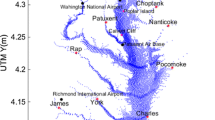Abstract
Given a marine basin of near homogeneous lithology, a known sea level curve, and known submarine abrasion rates, a model is developed to estimate the volume of material eroded by marine action. Assumptions of the model are that erosion is effected solely by submarine abrasion, which is assumed known and uniform through time, and that the volume eroded is small relative to the total volume of the basin. The basis of the model is that the volume eroded V, between time limits t1 andt 2,is essentially a function of the perimeter length l of the basin, which in turn is time-dependent on the sea level curve, so that
where k is an abrasion rate constant. The model was tested on Kiel Bay, Western Baltic, a shallow semienclosed, essentially nontidal sea, for which considerable data is available. Critical for numerical integration of the model is the k value, representing the volume eroded from the shore normal profile per unit length of shoreline per year. A number of possible k values were utilized, the most likely realizing a total volume eroded over the past 9000 y, since the sea first entered Kiel Bay, of 2.60×109 m 3. From this model, long-term average vertical submarine abrasion rates for Kiel Bay can be deduced as being between 0.001 and 0.0004 m/y.
An extension to the model analyzes the effect of sea level transgression rate on whether cliffs develop and predicts the theoretical form of the submarine profile based on varying abrasion rates summarized as
Here the origin x=0, yB=0 is chosen horizontally at the position where cliff formation first occurs, and vertically at the sea level at that time. The coordinate x measures distance inshore from the origin, yB(x) is the vertical position of the sea floor, aT(x) is the total depth abraded, tanθ is the original land surface slope, Vc the rate of cliff retreat, and h(t) the sea-level at time t. The synthetic profiles are compared to actual erosional profiles from representative sectors of Kiel Bay. The model predicts cliff development began at about 5800 yB.P., resulting in submarine abrasion profile lengths of about 1740 m and cliff heights of about 17.4 m for original land surface slopes of 0.01. This agrees to within about 10% of mean values obtained from bathymetric and topographic maps.
Similar content being viewed by others
References
Abramowitz, M., and Stegun, I. A., 1965, Handbook of mathematical functions: Dover, 590 p.
Balzer, W., 1986, Forms of phosphorus and its accumulation in coastal sediments of Kieler Bucht: Ophelia (in press).
Bradley, W. C. 1958, Submarine abrasion and wave-cut platforms: Geol. Soc. Amer. Bull. v. 69, p. 967–974.
Dietz, R. S., 1963, Wave-base, marine profile of equilibrium, and wave built terraces: a critical appraisal: Geol. Soc. Amer. Bull. v. 74, p. 971–990.
Duphorn, K., 1979, The Quaternary history of the Baltic. The Federal Republic of Germany: Acta Universitat Uppsala, Symposium University of Uppsala Annum Quingentesimum Celebrantus, 1, p. 195–206.
Erlenkeuser, H., Suess, E., and Willkomm, H., 1974, Industrialisation affects heavy metal and carbon isotope concentrations in recent Baltic Sea Sediments: Geochim. Cosmochim. Acta, v. 38, p. 823–842.
Exon, N. F., 1972, Sedimentation in the outer Flensburg Fjord Area (Baltic Sea) since the last Glaciation: Meyniana, v. 22, p. 5–62.
Flemming, B., and Wefer, G., 1973, Tauchbeobachtungen an Wellenripplen und Abrasionser-scheinungen in der Westlichen Ostsee südostlich Bokniseck: Meyniana, v. 23, p. 9–18.
Flemming, N. C., 1965, Form and relation to present sea level of Pleistocene erosion features: J. Geol., v. 73, p. 799–811.
Healy, T. R., 1973, Structure and Terrain of the Sydney Area: Proc. Ecol. Soc. Austral., v. 7, p. 24–40.
Healy, T. R., 1981, Submarine terraces and morphology in the Keiler Bucht, Western Baltic, and their relation to late Quaternary events: Boreas, v. 10, p. 209–217.
Healy, T. R., and Wefer, G., 1979, The efficacy of submarine abrasion vs cliff retreat as a supplier of sediment in the Kieler Bucht, Western Baltic: Meyniana, v. 32, p. 89–96.
Healy, T. R., and Werner, F. 1987, Sediment budget for a semi-enclosed sea in a near homogeneous lithology; example of Kiel Bay, Western Baltic: Senckenbergiana maritima, v. 19 (in press).
Hinz, K., Kogler, F., Richter, I., and Seibold, E., 1971, Reflexionsseismische Untersuchungen mit einer pneumatischen Schallquelle und einem Sedimentecholot in der westlichen Ostsee. Teil II: Meyniana, v. 21, p. 17–24.
Seibold, E., Exon, N., Hartmann, M., Kögler, F-C., Krumm, H., Lutze, G. F., Newton, R. S., Werner, F., 1971, Marine geology of Kiel Bay,in G. Miller (ed.), Sedimentology of parts of Central Europe: Guidebook, VIIIth International Sedimentological Congress 1971: Kramer, Frankfurt, p. 209–235.
Strahler, A. N., 1952, Hypsometric (area-altitude) analysis of erosional topography: Geol. Soc. Amer. Bull. v. 63, p. 1117–1142.
Sunamura, T., 1978a, A model of the development of continental shelves having erosional origin: Geol. Soc. Amer. Bull. v. 89, p. 504–510.
Sunamura, T., 1978b, A mathematical model of submarine platform development: Math. Geol. v. 10, p. 53–58.
Sunamura, T., 1983, Processes of sea cliff and platform formation,in P. D. Komar (ed.), C.R.C. Handbook of Coastal Processes and Erosion: C.R.C. Press, Florida, p. 233–264.
Wefer, G., and Tauchgruppe Kiel, 1974, Topographie und Sedimente im “Hausgarten” des Sonderforschungsbereichs 95 der Universität Kiel (Eckernförder Bucht, Westliche Ostsee): Meyniana, v. 26, p. 3–7.
Wefer, G., Flemming, B., and Tauchgruppe Kiel, 1976, Submarine abrasion des Geschiebemergels vor Bokniseck (Westliche Ostsee): Meyniana, v. 28, 87–94.
Werner, F., 1967, Sedimentation und abrasion am Mittegrund (Eckernförder Bucht, Westliche Ostsee): Meyniana, v. 17, p. 101–110.
Winn, K., Averdieck, F-R., and Werner, F., 1982, Spät-und postglaziale Entwicklung des Vejsnaes-Gebietes (Westliche Ostsee): Meyniana, v. 34, p. 1–28.
Author information
Authors and Affiliations
Rights and permissions
About this article
Cite this article
Healy, T.R., Sneyd, A.D. & Werner, F. First approximation sea-level dependent mathematical model for volume eroded and submarine profile development in a semienclosed sea: Kiel Bay, Western Baltic. Math Geol 19, 41–56 (1987). https://doi.org/10.1007/BF01275433
Received:
Accepted:
Issue Date:
DOI: https://doi.org/10.1007/BF01275433




